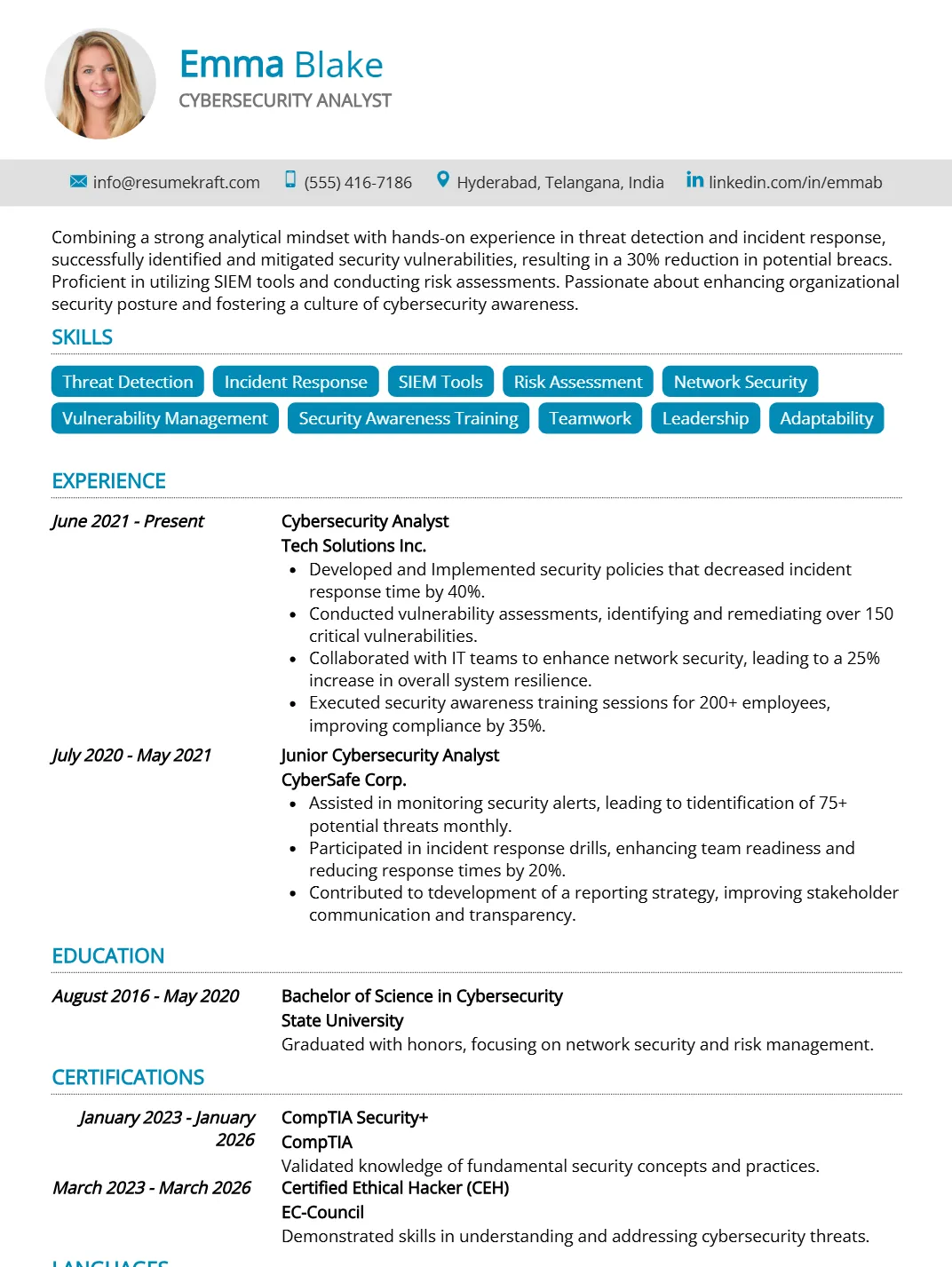
The role of a Cybersecurity professional has become increasingly critical in today’s digital landscape, where threats to sensitive information and systems are on the rise. Cybersecurity experts are responsible for safeguarding organizations from cyberattacks by implementing security protocols, monitoring networks, and responding to incidents. As businesses increasingly rely on technology, the demand for skilled cybersecurity professionals continues to grow, making it a lucrative field with diverse career opportunities. This article aims to provide insights into effective resume writing for cybersecurity roles, highlighting essential skills and strategies to stand out in this competitive job market.
- Cybersecurity resume examples
- How to format a Cybersecurity resume template
- How to write your Cybersecurity resume experience
- How to list your hard skills and soft skills on your resume
- How to list your certifications and education on your resume
- How to write your Cybersecurity resume summary or objective
- Additional sections for a Cybersecurity resume
- Key takeaways for writing a professional Cybersecurity resume
- Frequently Asked Questions
Cybersecurity resume examples
Cybersecurity resume examples serve as valuable resources for job seekers looking to break into or advance within the field. These examples highlight key elements of effective resumes tailored to the cybersecurity industry, showcasing relevant skills, certifications, and experiences. By analyzing these samples, candidates can better understand how to present their qualifications in a way that resonates with hiring managers and stands out in a competitive job market.
Cybersecurity Analyst Resume

Why This Resume Works
This resume effectively highlights relevant skills and experience for a Cybersecurity Analyst position, showcasing expertise in threat detection, incident response, and SIEM tools. With approximately five years of progressive experience, it demonstrates a solid foundation in network security and risk assessment. The clear format enhances readability for hiring managers and is optimized for ATS compatibility through the use of industry-specific keywords. Additionally, strategic presentation of accomplishments emphasizes quantifiable impact in previous roles, making this resume compelling for potential employers in cybersecurity.
Cybersecurity Engineer Resume
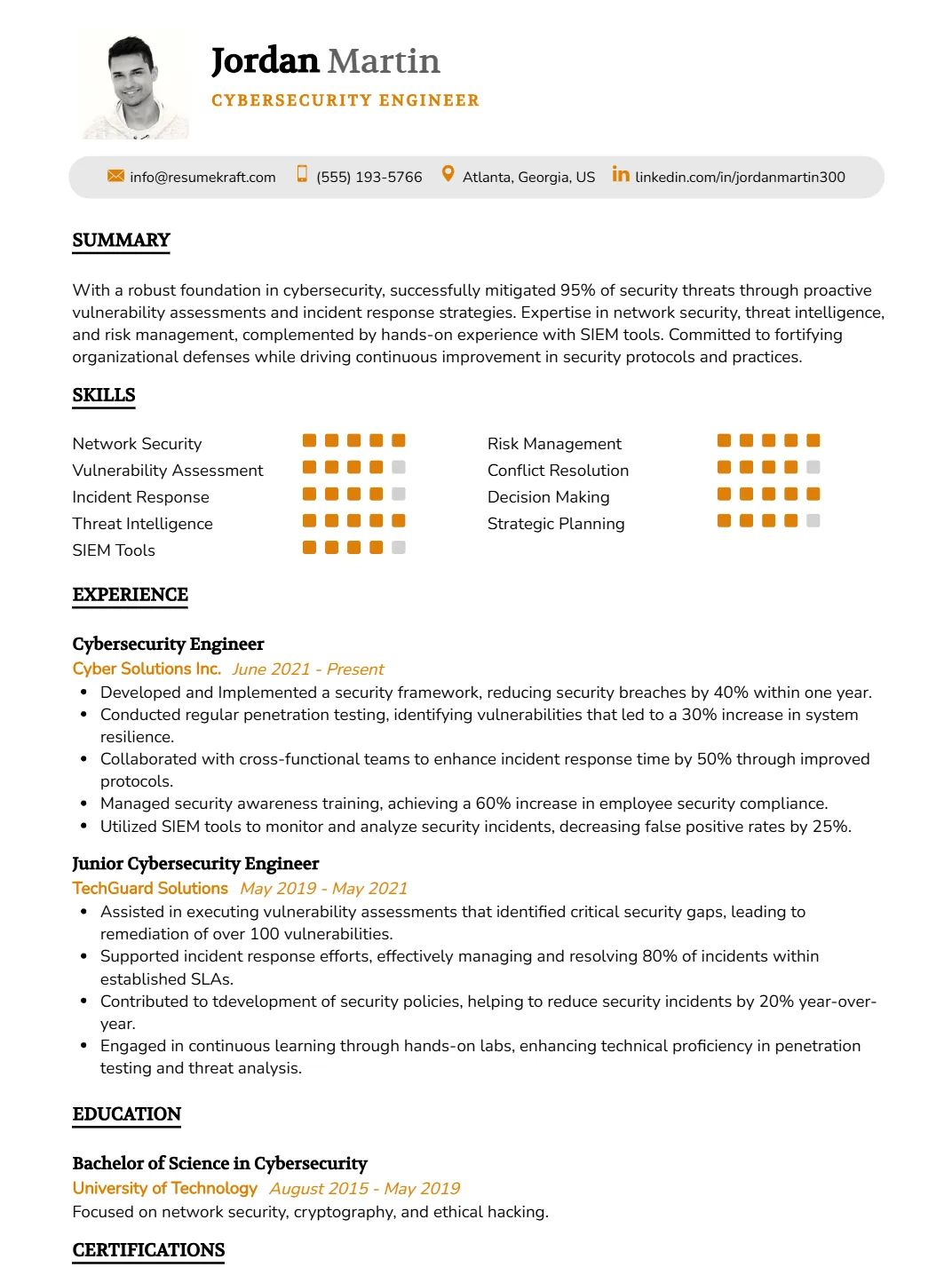
Why This Resume Works
This resume effectively highlights the candidate’s relevant skills, including Network Security and Incident Response, essential for a Cybersecurity Engineer role. The structured format showcases approximately six years of progressive experience, making their expertise clear and accessible. By incorporating industry-specific keywords, the resume enhances ATS compatibility, ensuring it passes initial screenings. Additionally, strategic presentation of achievements related to Vulnerability Assessment and Threat Intelligence underscores the candidate’s impact in past roles, aligning perfectly with the demands of this position in cybersecurity.
Cybersecurity Specialist Resume

Why This Resume Works
This resume effectively highlights the candidate’s relevant skills in network security, threat assessment, and incident response, directly aligning with the requirements for a Cybersecurity Specialist. The structure ensures clarity, with distinct sections for key competencies and professional experience that enhance readability. Additionally, the use of industry-specific keywords boosts ATS compatibility, increasing visibility to recruiters. Strategic presentation of achievements showcases measurable impacts in previous roles, further emphasizing the candidate’s qualifications and ability to contribute meaningfully to cybersecurity initiatives.
Cybersecurity Consultant Resume

Why This Resume Works
This resume effectively highlights the candidate’s relevant skills in Risk Assessment, Threat Analysis, and Incident Response, aligning perfectly with the Cybersecurity Consultant position. The structured format emphasizes key competencies and presents a clear progression of responsibilities over 7 years, showcasing expertise in compliance frameworks like NIST and ISO 27001. Its ATS-friendly design ensures that critical keywords are easily recognizable. Additionally, strategic presentation of achievements related to successful penetration testing and incident management demonstrates the candidate’s impact in previous roles, making them a strong fit for.
Cybersecurity Architect Resume
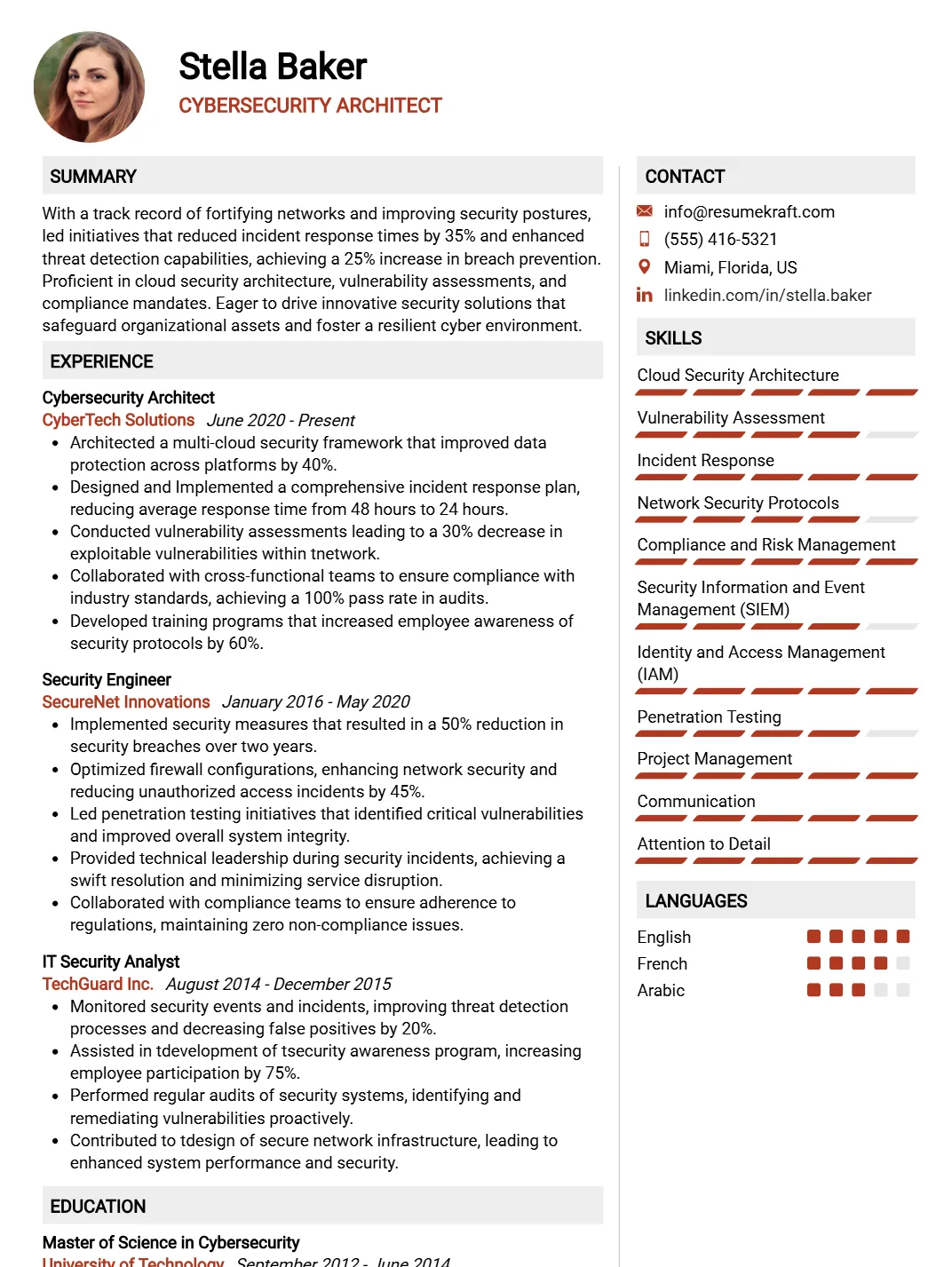
Why This Resume Works
This resume effectively positions the candidate for a Cybersecurity Architect role by showcasing relevant skills such as Cloud Security Architecture and Incident Response, directly aligning with industry demands. With nearly 10 years of progressive experience in cybersecurity roles, the candidate demonstrates depth and expertise. The structured format enhances readability, making it ATS-friendly while ensuring key qualifications are easily identifiable. Strategic presentation of achievements underscores successful implementations in compliance and risk management, further illustrating the candidate’s capacity to excel in this critical position.
Information Security Analyst Resume
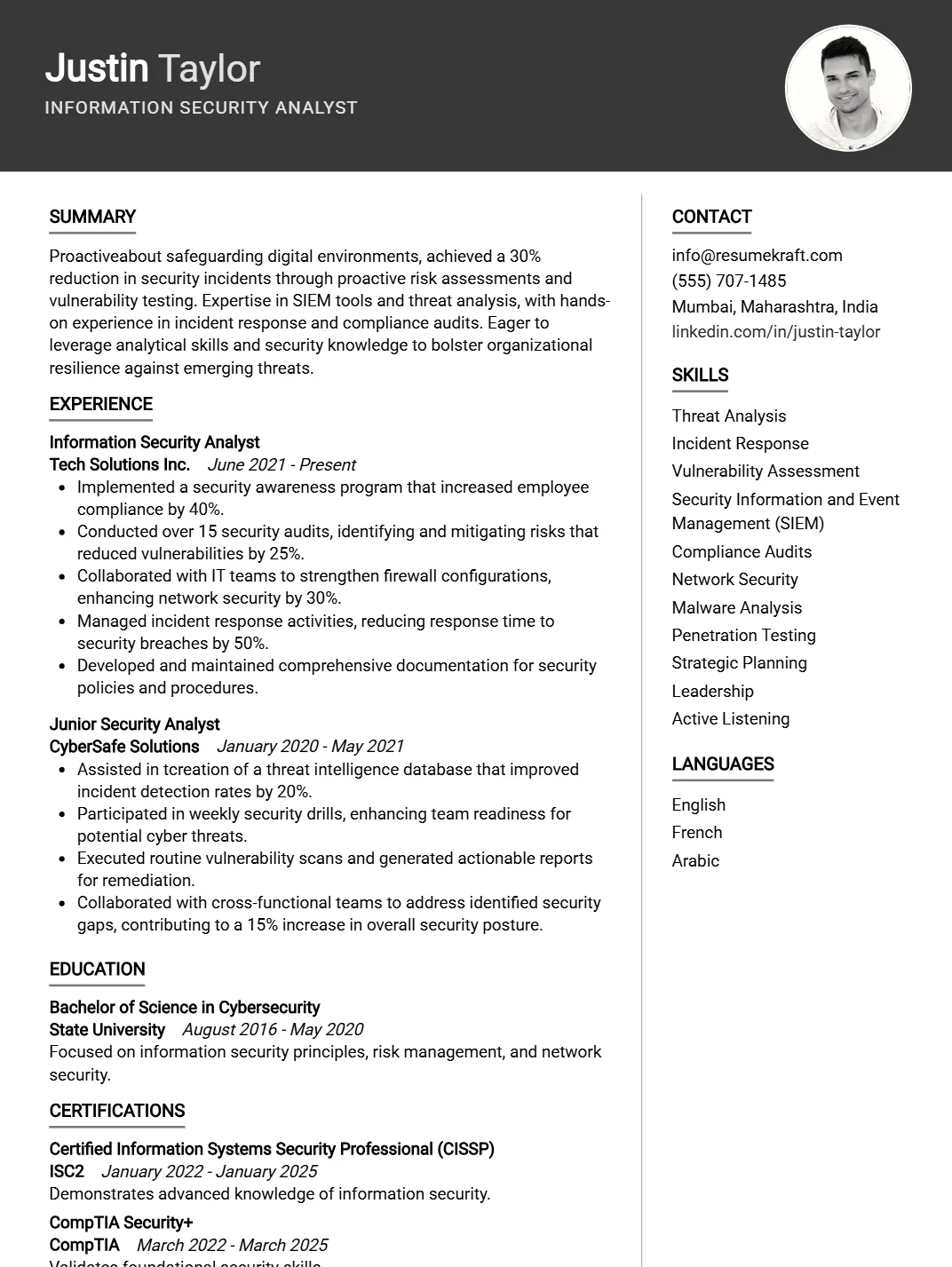
Why This Resume Works
This resume effectively highlights the candidate’s relevant skills, such as Threat Analysis and Incident Response, directly aligning with the Information Security Analyst position. The structured layout ensures clarity, making it easy for hiring managers to identify key competencies. Its strategic use of industry-specific keywords enhances ATS compatibility, ensuring the resume passes initial screenings. Furthermore, the presentation of achievements demonstrates tangible impacts in previous roles, showcasing the candidate’s ability to protect organizational assets—critical for success in information security.
Information Security Engineer Resume
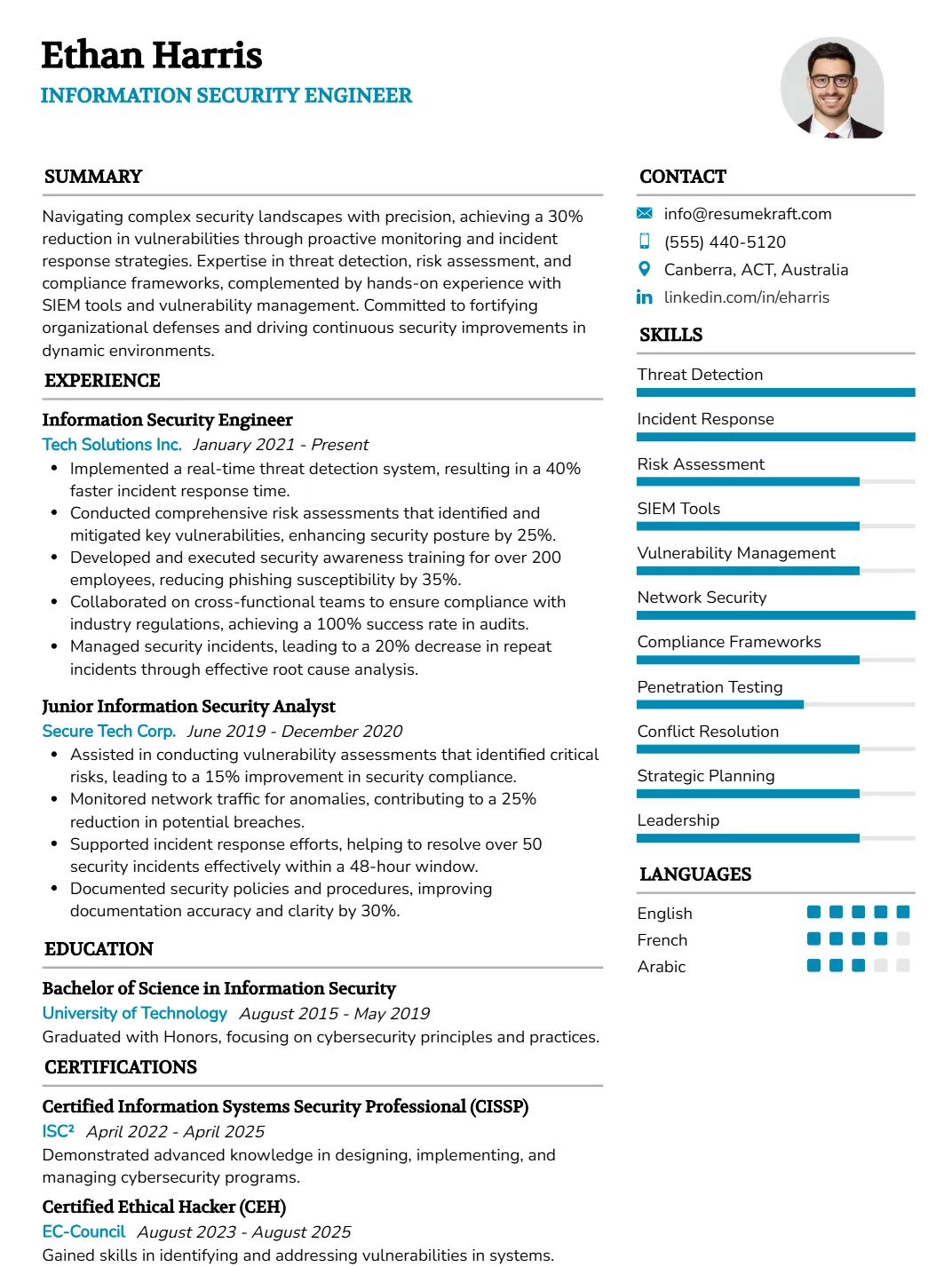
Why This Resume Works
This resume effectively highlights the candidate’s expertise as an Information Security Engineer through a targeted presentation of key skills like Threat Detection and Incident Response. With approximately five years of relevant experience, including roles as both an Information Security Engineer and Junior Analyst, it demonstrates a solid career progression. The structured format enhances readability for hiring managers while ensuring compatibility with ATS systems by incorporating industry-specific keywords.
Security Operations Center (SOC) Analyst Resume
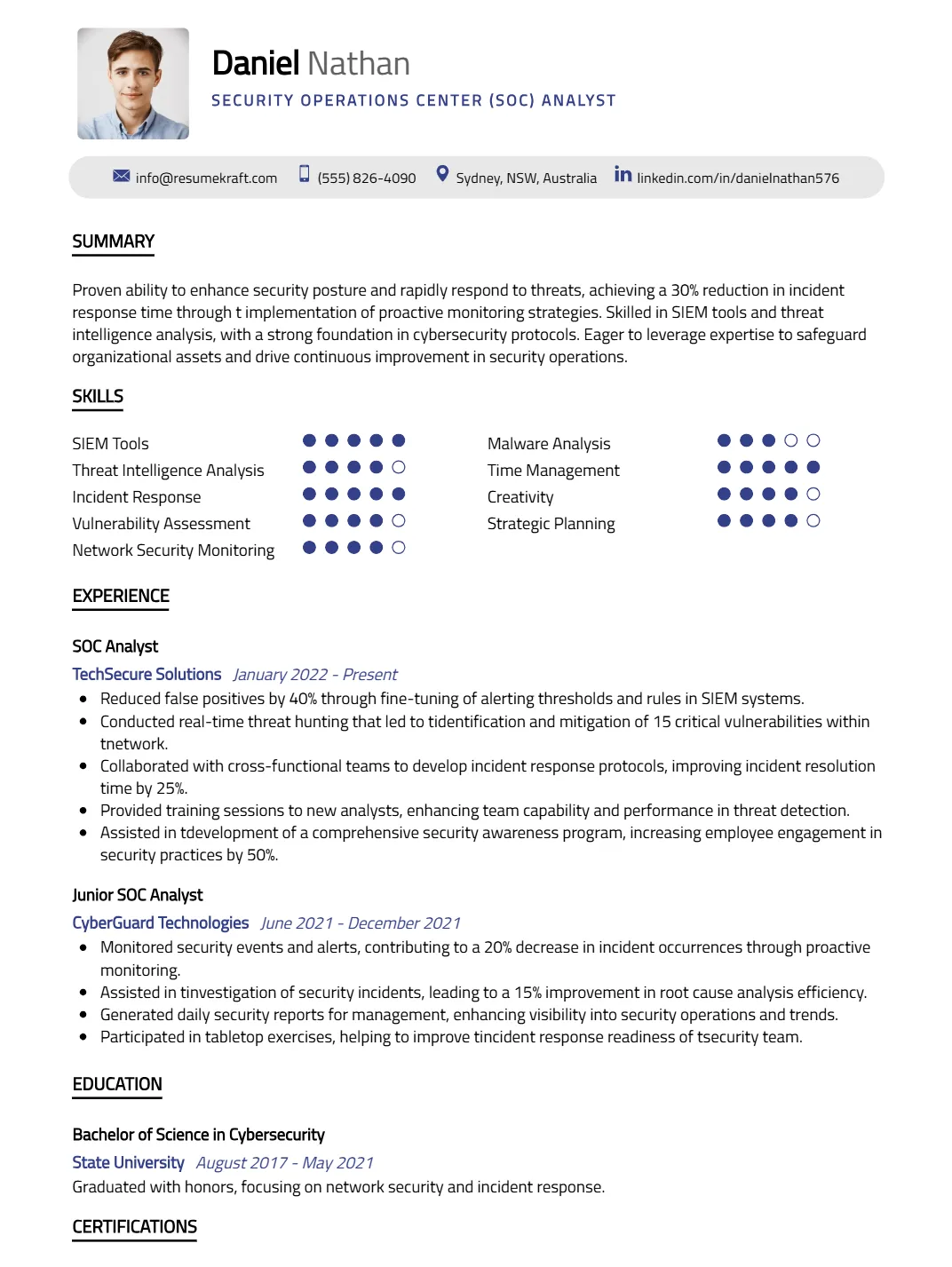
Why This Resume Works
This resume effectively highlights relevant skills like SIEM tools and incident response, crucial for a Security Operations Center (SOC) Analyst position. With three years of progressively responsible experience as a SOC Analyst and Junior SOC Analyst, it demonstrates a solid foundation in network security monitoring and threat intelligence analysis. The clear format enhances readability, while strategic keyword placement ensures ATS compatibility. Additionally, the presentation of quantifiable achievements showcases the candidate’s impact in previous roles, making this resume stand out in a competitive field.
Network Security Engineer Resume
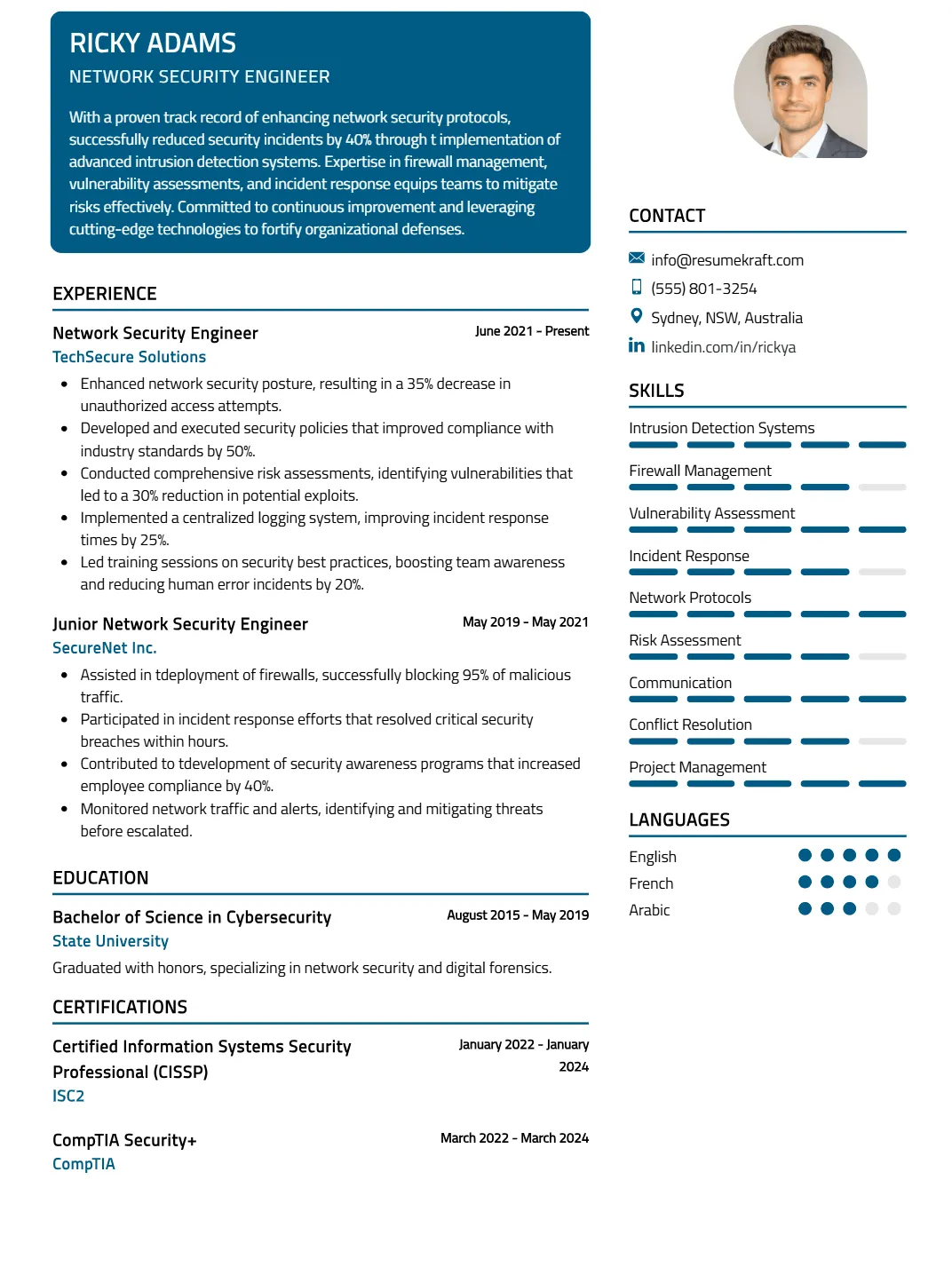
Why This Resume Works
This resume effectively showcases the candidate’s qualifications for a Network Security Engineer position by highlighting key skills such as Intrusion Detection Systems and Firewall Management, which are crucial in this field. With approximately six years of relevant experience, the structured format emphasizes both roles held and key achievements, ensuring clarity and professionalism. Additionally, the use of industry-specific keywords optimizes ATS compatibility, increasing visibility to hiring managers. Overall, this strategic presentation aligns well with the requirements of network security roles, making it stand out.
Application Security Engineer Resume
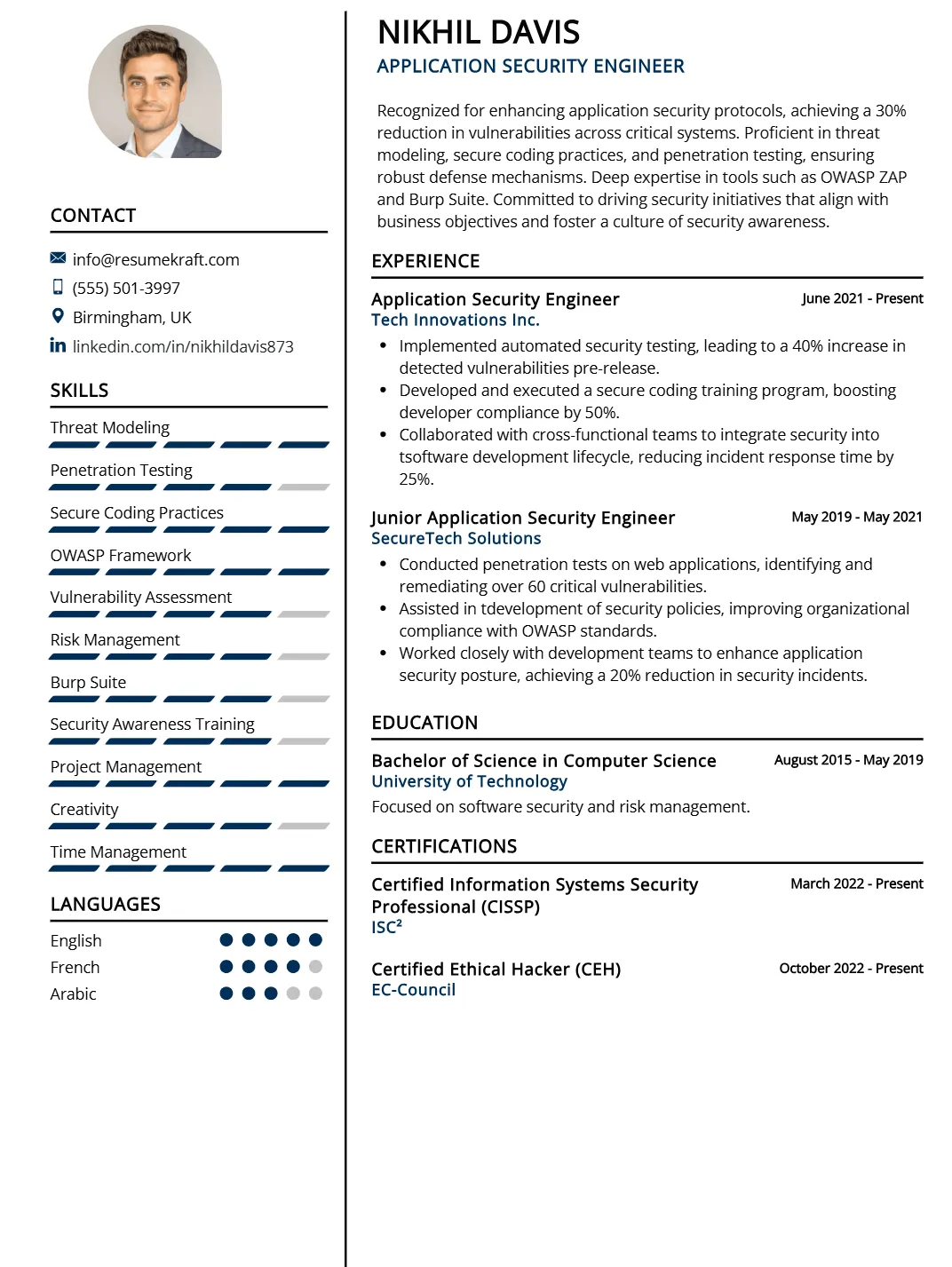
Why This Resume Works
This resume effectively showcases the candidate’s qualifications for an Application Security Engineer position by highlighting essential skills such as Threat Modeling, Penetration Testing, and Secure Coding Practices. With approximately six years of relevant experience, it demonstrates a clear progression from Junior to Application Security Engineer, indicating growth and expertise. The structured format enhances readability for hiring managers and ensures ATS compatibility by including industry-specific keywords. Additionally, strategic presentation of achievements in vulnerability assessments underscores the candidate’s impact and alignment with key responsibilities in this field.
Cloud Security Engineer Resume
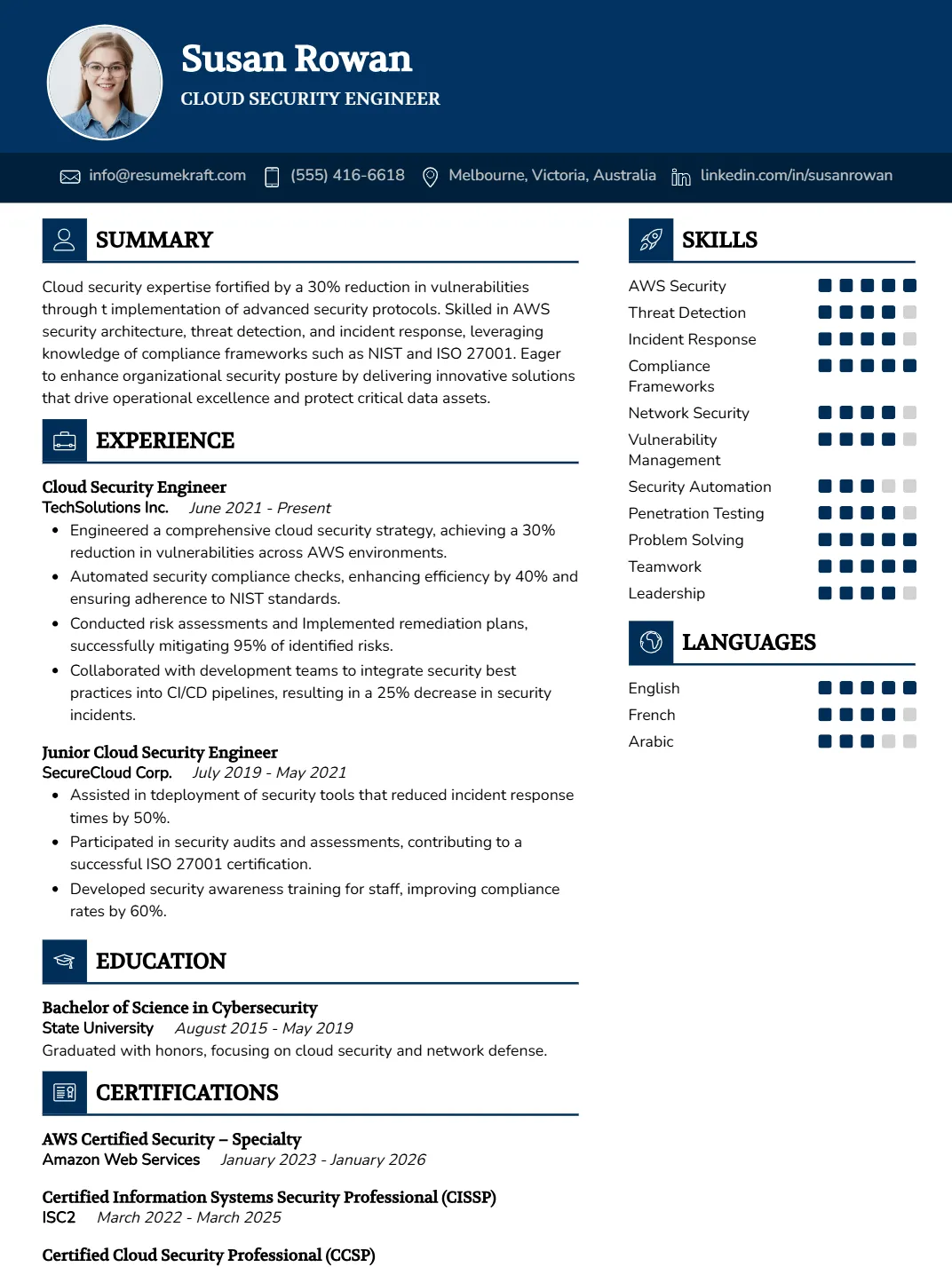
Why This Resume Works
This resume effectively highlights relevant skills such as AWS Security and Threat Detection, aligning perfectly with the Cloud Security Engineer role. With six years of progressive experience, it showcases a clear career trajectory from Junior Cloud Security Engineer to the current position. The structured format ensures easy readability for hiring managers and optimizes ATS compatibility through strategic keyword usage. Additionally, the resume emphasizes quantifiable achievements in incident response and compliance frameworks, underscoring the candidate’s impact and relevance in the cloud security field.
Penetration Tester Resume
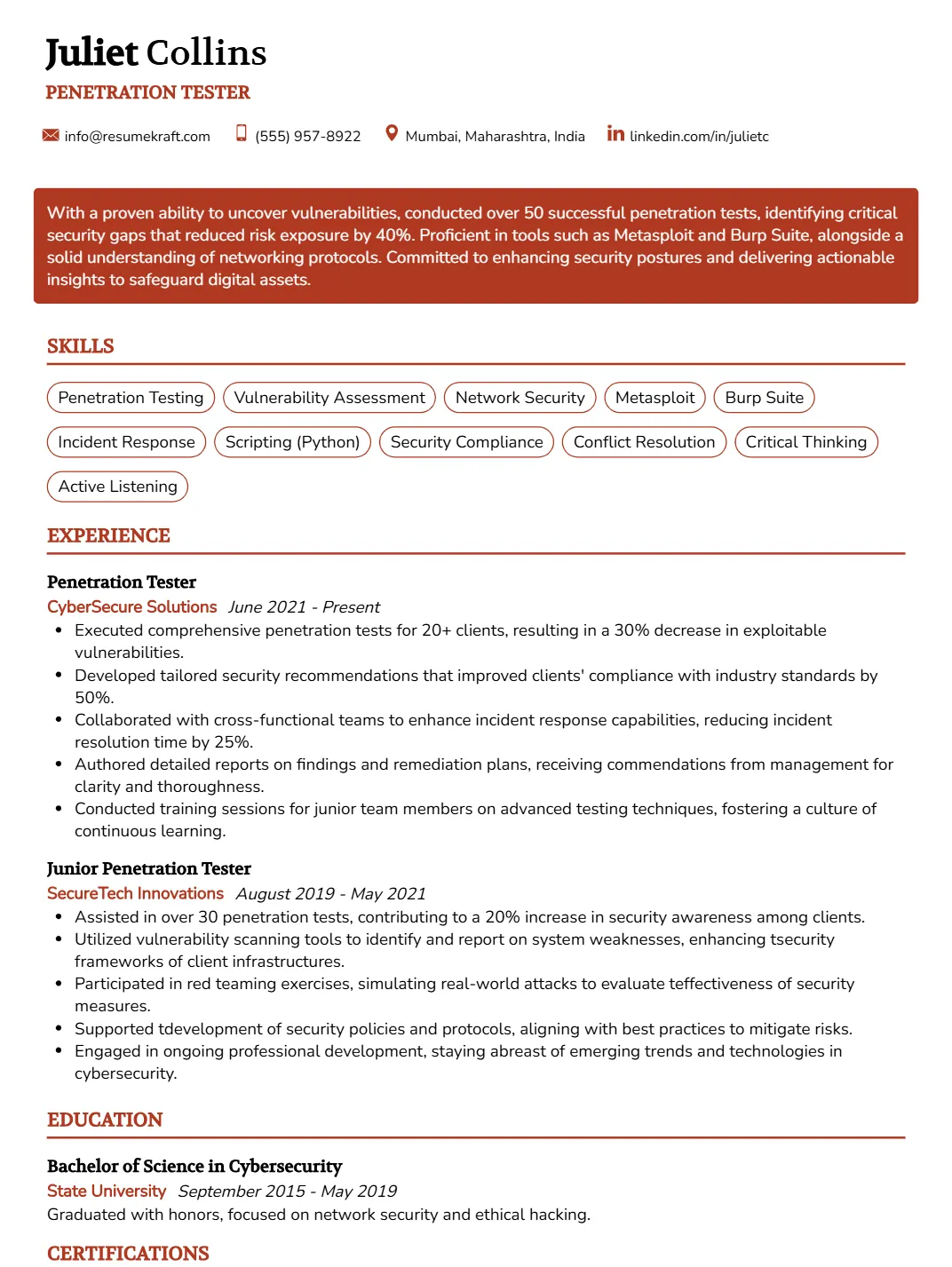
Why This Resume Works
This resume effectively highlights the candidate’s relevant experience and key skills, such as Penetration Testing and Vulnerability Assessment, which are critical for a Penetration Tester role. The structured format allows for easy readability, showcasing qualifications clearly to hiring managers. Additionally, it utilizes industry-specific keywords that enhance ATS compatibility, ensuring it passes automated screenings. The strategic presentation of achievements demonstrates the candidate’s impact in previous roles, making them an attractive prospect for employers seeking proficient professionals in network security and ethical hacking.
Ethical Hacker Resume
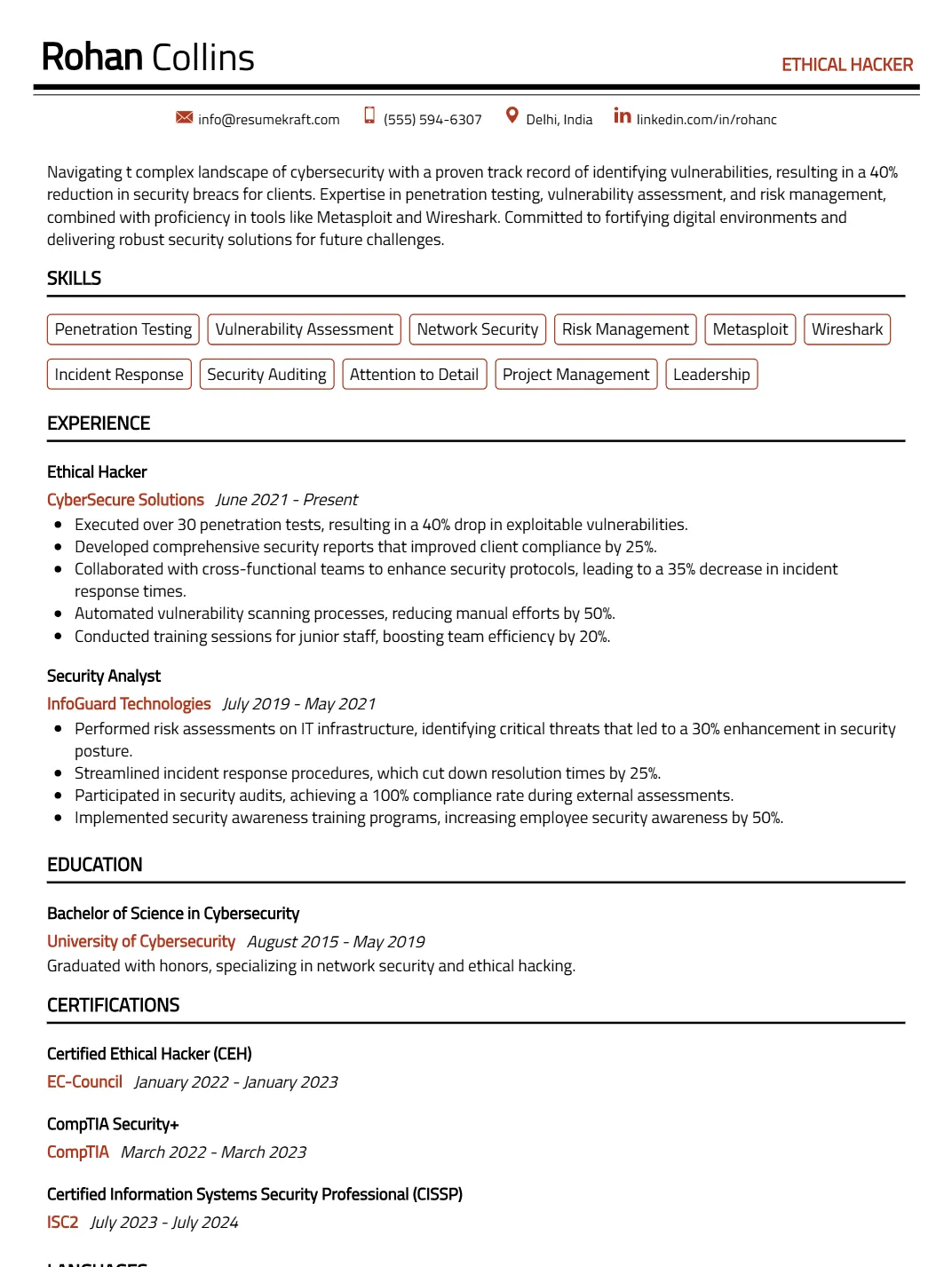
Why This Resume Works
This resume effectively highlights the candidate’s key skills in penetration testing, vulnerability assessment, and network security, directly aligning with the requirements of an Ethical Hacker position. With approximately six years of relevant experience as an Ethical Hacker and Security Analyst, it showcases a solid professional background. The structured format enhances readability for hiring managers and ensures ATS compatibility through targeted keywords. Additionally, the strategic presentation of achievements emphasizes impactful contributions to risk management and security enhancements, making it compelling for potential employers in this field.
Incident Response Analyst Resume
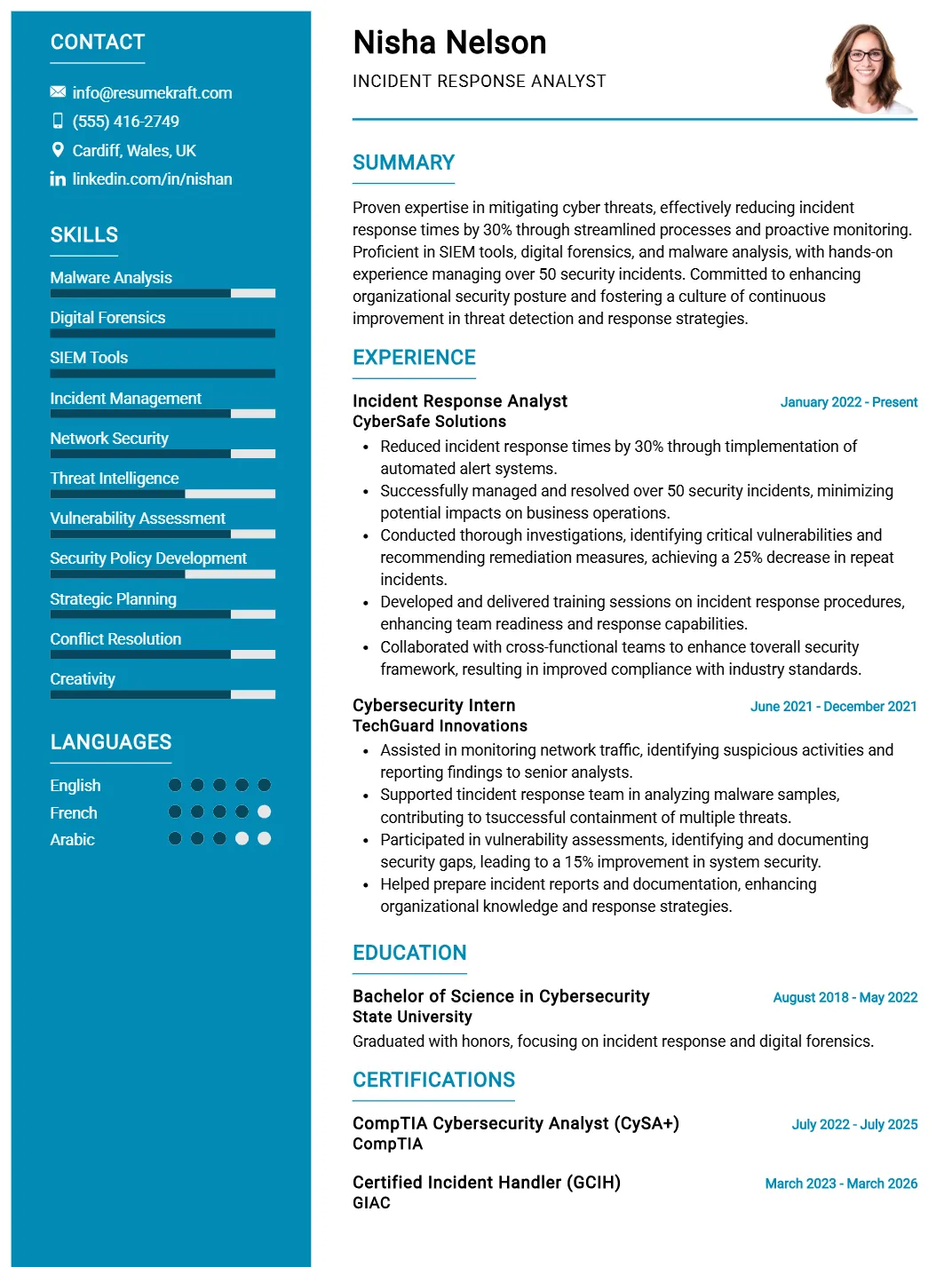
Why This Resume Works
This resume effectively showcases the candidate’s qualifications for an Incident Response Analyst position through a clear emphasis on relevant skills like Malware Analysis and Digital Forensics. The structured format highlights three years of targeted experience, enhancing credibility. Its ATS-friendly design utilizes industry-specific keywords, ensuring visibility in digital screenings. Additionally, the strategic presentation of achievements in incident management and network security demonstrates measurable impact, making the candidate stand out as a capable professional ready to address complex cybersecurity challenges.
Security Compliance Analyst Resume
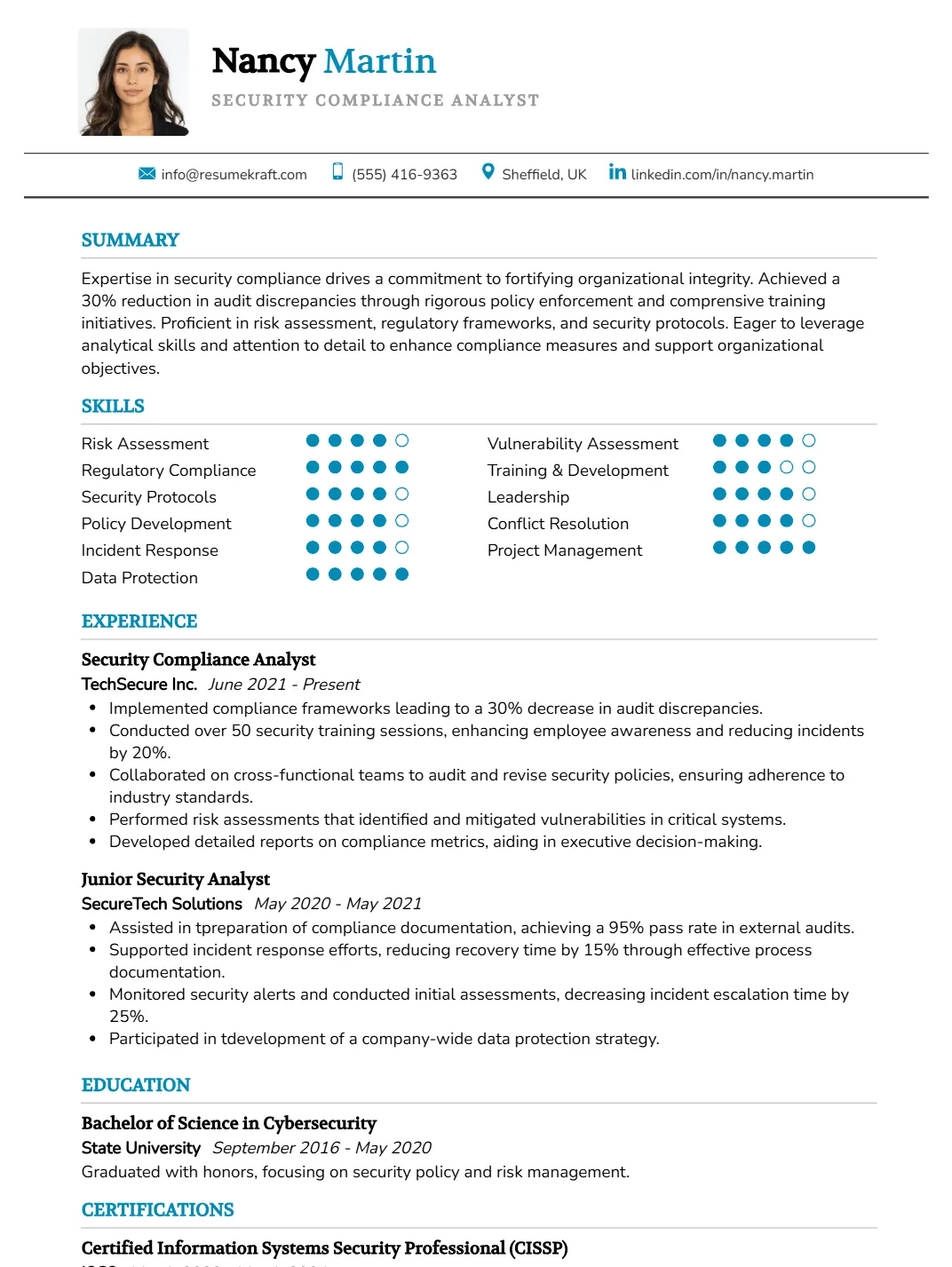
Why This Resume Works
This resume effectively highlights the candidate’s relevant skills, including Risk Assessment and Regulatory Compliance, essential for a Security Compliance Analyst. With five years of experience in both Security Compliance Analyst and Junior Security Analyst roles, it demonstrates a solid career progression. The structured format enhances readability, showcasing key competencies prominently. Additionally, it incorporates industry-specific keywords for ATS compatibility, ensuring visibility to recruiters. Strategic presentation of achievements, such as successful policy development and incident response initiatives, further underscores the candidate’s suitability for this role.
Chief Information Security Officer (CISO) Resume
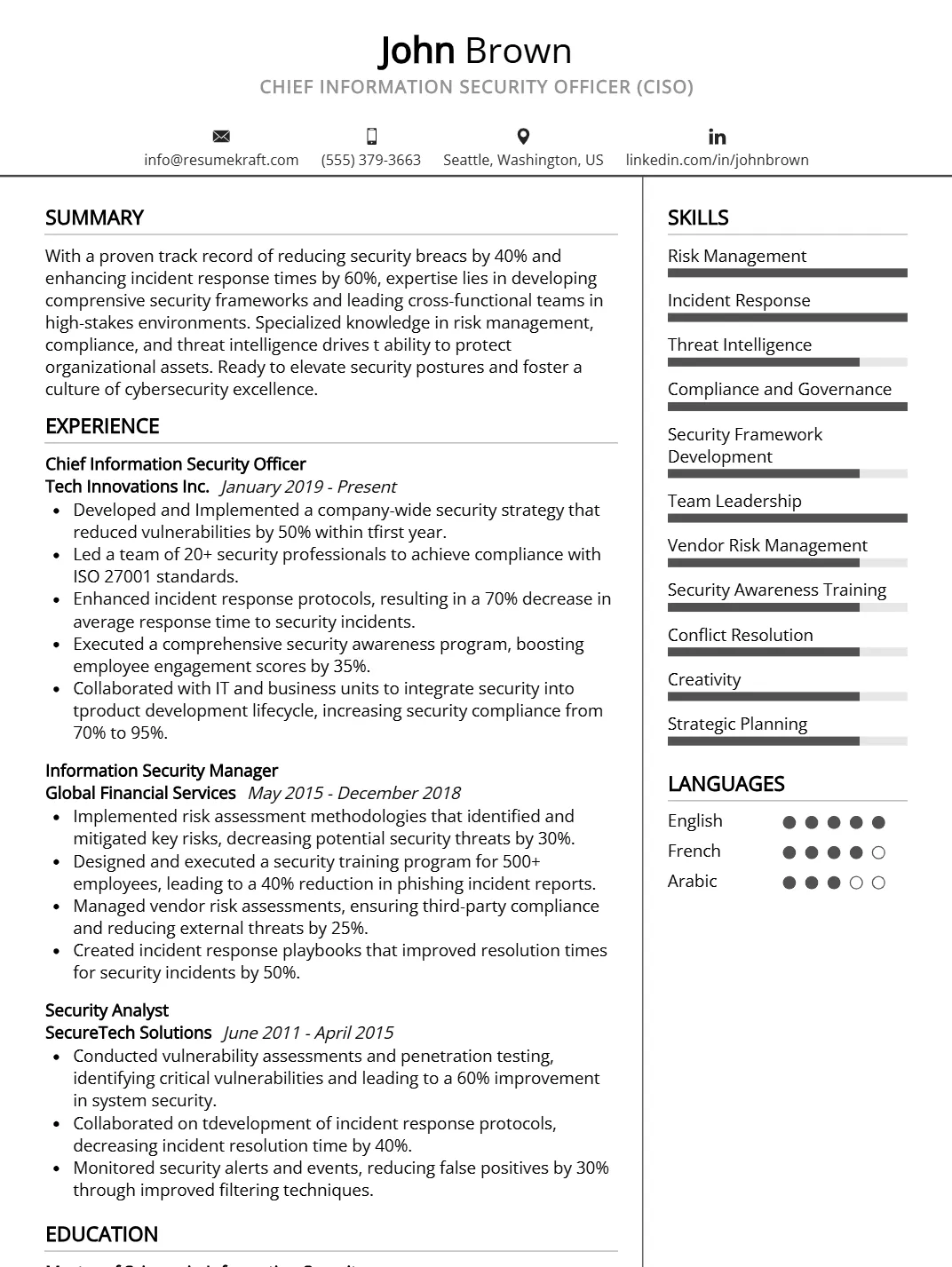
Why This Resume Works
This resume effectively positions the candidate for a Chief Information Security Officer role by showcasing 13 years of experience across key security domains. The emphasis on critical skills like Risk Management and Incident Response aligns perfectly with CISO responsibilities. Its structured format highlights achievements in governance and compliance, making it easy for hiring managers to identify qualifications at a glance. Additionally, the use of industry-specific keywords enhances ATS compatibility, ensuring visibility in digital screenings while strategically presenting accomplishments relevant to cybersecurity leadership.
Threat Intelligence Analyst Resume
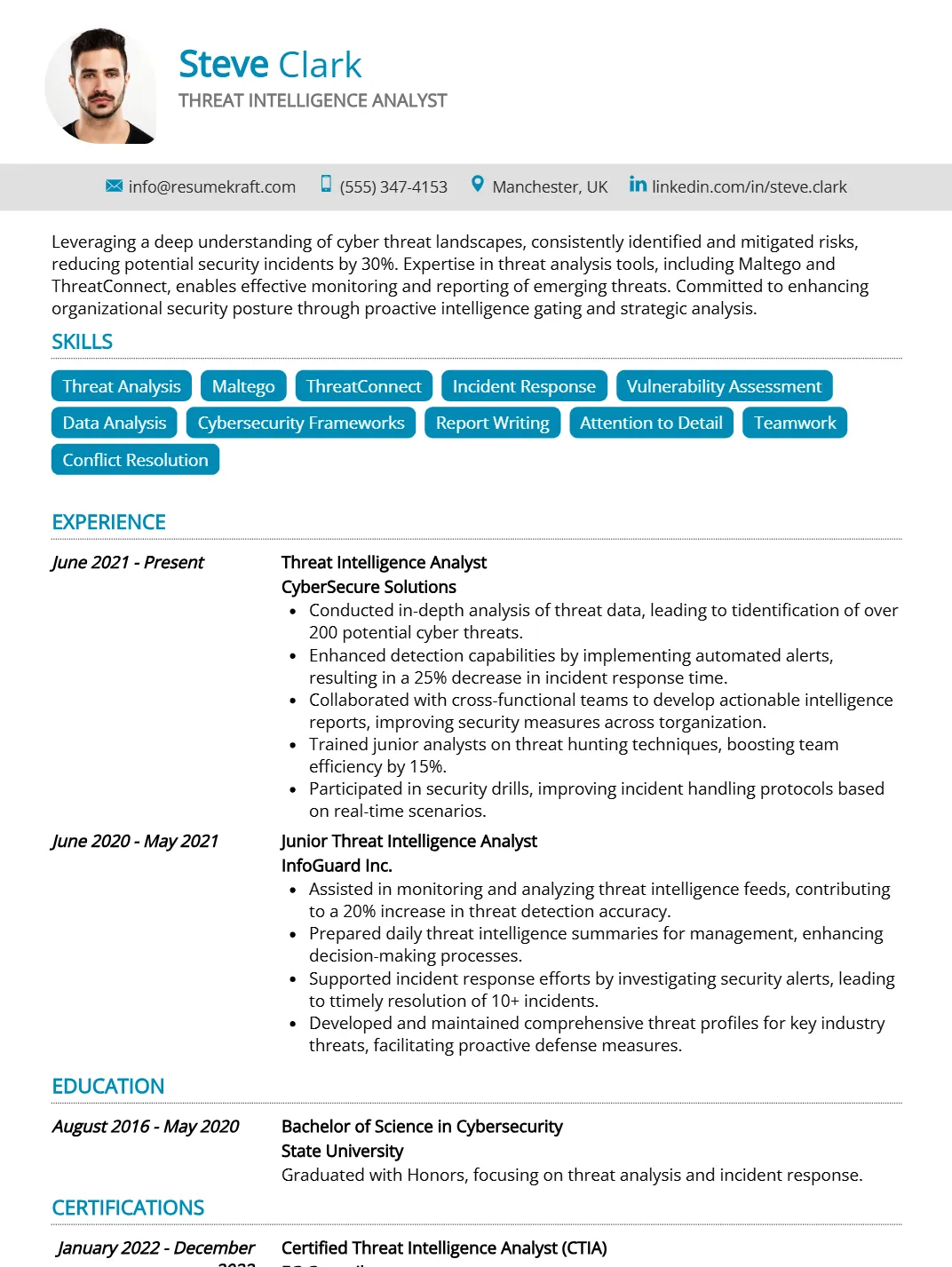
Why This Resume Works
This resume effectively highlights the candidate’s relevant experience and skills tailored for a Threat Intelligence Analyst role, showcasing five years of progressive experience. The inclusion of key tools like Maltego and ThreatConnect emphasizes technical expertise crucial for threat analysis and incident response. Its clear structure enhances readability, aiding ATS compatibility by incorporating industry-specific keywords. Additionally, strategic presentation of achievements related to vulnerability assessments underscores the candidate’s impact in previous roles, making this resume compelling for hiring managers seeking qualified professionals in threat intelligence.
How to format a Cybersecurity resume template
In the competitive field of Cybersecurity, a well-structured resume format is crucial for making a strong first impression. Proper formatting not only enhances readability but also highlights your technical skills effectively.
- Use a clean, professional layout with clear headings and bullet points to improve readability. This structure allows hiring managers to quickly identify your key qualifications.
- Incorporate industry-specific keywords throughout your resume to pass Applicant Tracking Systems (ATS). Tailoring your resume to each job description enhances visibility to recruiters.
- Prioritize your most relevant experience by placing it near the top of your resume. Highlight positions that demonstrate your cybersecurity expertise and problem-solving capabilities.
- Include certifications and technical skills in a dedicated section, using a simple table format for clarity. This makes it easy for employers to see your qualifications at a glance.
- Limit your resume to one page if you have less than 10 years of experience. This concise format encourages you to focus on your most impactful achievements and skills.
How to write your Cybersecurity resume experience
When crafting a Cybersecurity resume, presenting your work experience effectively is crucial as it showcases your technical skills and problem-solving abilities in real-world scenarios. Employers look for specific achievements and metrics that demonstrate your ability to protect systems and data, as well as your experience in mitigating risks and responding to incidents.
Worked in IT security. Helped with some security audits and fixed minor issues. Occasionally reported to my manager.
Conducted 15+ security audits, identifying vulnerabilities that reduced risk exposure by 30%. Collaborated with cross-functional teams to implement security protocols that led to a 20% decrease in incidents.
How to list your hard skills and soft skills on your resume
In the rapidly evolving field of Cybersecurity, showcasing both hard and soft skills on your resume is crucial for standing out to potential employers. Hard skills demonstrate your technical expertise and proficiency in tools and methodologies necessary for protecting digital information, while soft skills highlight your ability to collaborate, communicate, and adapt in high-pressure environments. Together, these skills present a well-rounded candidate capable of addressing diverse challenges in Cybersecurity.
Hard Skills:
- Network Security: Knowledge of protecting networking systems from breaches and attacks.
- Intrusion Detection Systems (IDS): Proficiency in tools that monitor network traffic for suspicious activity.
- Firewalls: Experience in configuring and managing firewalls to safeguard networks.
- Encryption Techniques: Understanding of data encryption methods to secure sensitive information.
- Incident Response: Ability to respond effectively to security breaches and mitigate damages.
- Vulnerability Assessment: Skills in identifying and evaluating security weaknesses in systems.
- Penetration Testing: Conducting simulated attacks to identify vulnerabilities in systems.
- Security Information and Event Management (SIEM): Utilizing SIEM tools for real-time analysis of security alerts.
- Malware Analysis: Capability to analyze and respond to malware threats.
- Risk Management: Implementing strategies to manage and minimize security risks.
- Compliance Standards: Knowledge of regulations like GDPR, HIPAA, and PCI-DSS.
- Cloud Security: Securing cloud infrastructures and understanding cloud-related risks.
- Operating Systems Security: Expertise in securing various operating systems like Windows and Linux.
- Identity and Access Management (IAM): Managing user access to systems securely.
- Security Audits: Conducting audits to ensure compliance and identify security gaps.
Soft Skills:
- Problem-Solving: Ability to analyze issues and develop effective solutions quickly.
- Attention to Detail: Ensuring thoroughness in security assessments and compliance checks.
- Communication: Clearly conveying technical information to non-technical stakeholders.
- Team Collaboration: Working effectively with diverse teams to enhance security measures.
- Adaptability: Quickly adjusting to new threats and changes in technology.
- Critical Thinking: Evaluating complex situations to make informed decisions.
- Time Management: Prioritizing tasks to meet deadlines in a fast-paced environment.
- Leadership: Guiding teams and projects towards achieving security goals.
- Emotional Intelligence: Understanding and managing interpersonal relationships judiciously.
- Creativity: Developing innovative strategies to combat emerging Cybersecurity threats.
- Ethics: Upholding high standards of integrity and responsibility in security practices.
- Negotiation: Effectively discussing security measures with stakeholders and clients.
- Stress Management: Staying calm and focused during security incidents or crises.
- Research Skills: Staying updated on the latest security trends and threats.
- Customer Service: Providing support and guidance to users regarding security protocols.
- Networking: Building relationships within the industry to share knowledge and resources.
How to list your certifications and education on your resume
When presenting certifications and education on a Cybersecurity resume, it is crucial to highlight relevant qualifications that align with the job requirements. Focus on industry-recognized certifications such as CISSP, CEH, and CompTIA Security+, as these demonstrate your expertise and commitment to the field. Additionally, include your degree(s) in Computer Science, Information Technology, or Cybersecurity, emphasizing any honors or relevant coursework.
Ensure that the information is clearly organized and easy to read. List certifications with the issuing organization and the date obtained, while your education should include the institution, degree type, and graduation year. This structured approach helps potential employers quickly assess your qualifications.
Went to college and got some certifications. I have a degree and a few random courses related to security.
Bachelor of Science in Cybersecurity, University of XYZ, Graduated May 2022. Certified Information Systems Security Professional (CISSP), Issued by (ISC)², June 2023.
How to write your Cybersecurity resume summary or objective
A strong resume summary or objective is crucial for a Cybersecurity position as it serves as a brief introduction, highlighting your key skills and experiences that make you a suitable candidate. A summary is particularly useful for those with extensive experience, allowing them to showcase their accomplishments and expertise. In contrast, an objective statement is ideal for entry-level candidates or those changing careers, as it focuses on career goals and the value they aim to bring to the organization.
Seeking a job in Cybersecurity where I can use my skills and knowledge to help the company. I am a fast learner and very passionate about technology.
Detail-oriented Cybersecurity Analyst with 5+ years of experience in threat detection and vulnerability management, seeking to leverage expertise in risk assessment at a forward-thinking tech firm.
Additional sections for a Cybersecurity resume
Including additional sections in your Cybersecurity resume can significantly enhance your candidacy by showcasing your specialized skills, certifications, and relevant experience. These sections provide potential employers with a more comprehensive view of your qualifications and dedication to the field.
- Certifications: Highlighting industry-recognized certifications such as CISSP, CEH, or CompTIA Security+ demonstrates your expertise and commitment to staying current with cybersecurity practices and standards.
- Projects: Detailing specific cybersecurity projects you’ve worked on illustrates your hands-on experience. This section can provide insight into your problem-solving skills and ability to implement practical solutions.
- Technical Skills: Listing relevant tools, programming languages, and technologies showcases your technical proficiency. This section assures employers that you possess the necessary skills to tackle cybersecurity challenges effectively.
- Professional Affiliations: Membership in organizations like ISACA or (ISC)² reflects your commitment to professional development and networking within the cybersecurity community, indicating you stay engaged with industry trends.
- Publications or Presentations: Including any relevant articles, blog posts, or presentations demonstrates thought leadership and expertise in your field, reinforcing your credibility and passion for cybersecurity.
Key takeaways for writing a professional Cybersecurity resume
- Highlight relevant certifications, such as CISSP or CEH, to demonstrate your expertise and commitment to cybersecurity best practices.
- Utilize resume templates specifically designed for cybersecurity roles to ensure your resume is both professional and tailored to industry standards.
- Quantify your achievements with specific metrics, such as the percentage of vulnerabilities reduced or incidents responded to, to showcase your impact.
- Leverage an ai resume builder to streamline the creation process and ensure your resume includes essential keywords that align with job descriptions.
- Customize your resume for each application, emphasizing experience that directly relates to the specific cybersecurity position you are pursuing.
Frequently Asked Questions
How long should my Cybersecurity resume be?
Your Cybersecurity resume should ideally be one page, especially if you have less than 10 years of experience. This concise format allows you to highlight your most relevant skills, certifications, and achievements clearly. If you have extensive experience, a two-page resume may be acceptable, but ensure that every piece of information adds value and is tailored to the position you’re applying for. Avoid fluff and focus on impactful accomplishments.
What is the best format for a Cybersecurity resume?
The best format for a Cybersecurity resume is the reverse chronological format. This layout emphasizes your most recent experience and achievements, making it easy for hiring managers to see your career progression. Start with a strong summary statement, followed by work experience, education, certifications, and relevant skills. Use bullet points for clarity and to highlight key accomplishments, ensuring that the document is well-organized and visually appealing.
What should I highlight on my Cybersecurity resume to stand out?
To stand out in your Cybersecurity resume, highlight your technical skills, relevant certifications (such as CISSP, CEH, or CISM), and hands-on experience with security technologies and protocols. Include specific projects where you successfully mitigated risks or improved security posture. Additionally, emphasize your soft skills, such as problem-solving, analytical thinking, and communication abilities, as they are crucial in collaborating with teams and stakeholders in cybersecurity roles.
What are some ways to quantify my experience on my Cybersecurity resume?
Quantifying your experience on a Cybersecurity resume can significantly enhance its impact. Use metrics such as the percentage of security incidents reduced, the number of vulnerabilities identified and mitigated, or the size of the budget managed for security initiatives. For example, stating that you “reduced incident response time by 30% through implementing new protocols” provides a clear picture of your effectiveness and contributions to the organization’s security efforts.

